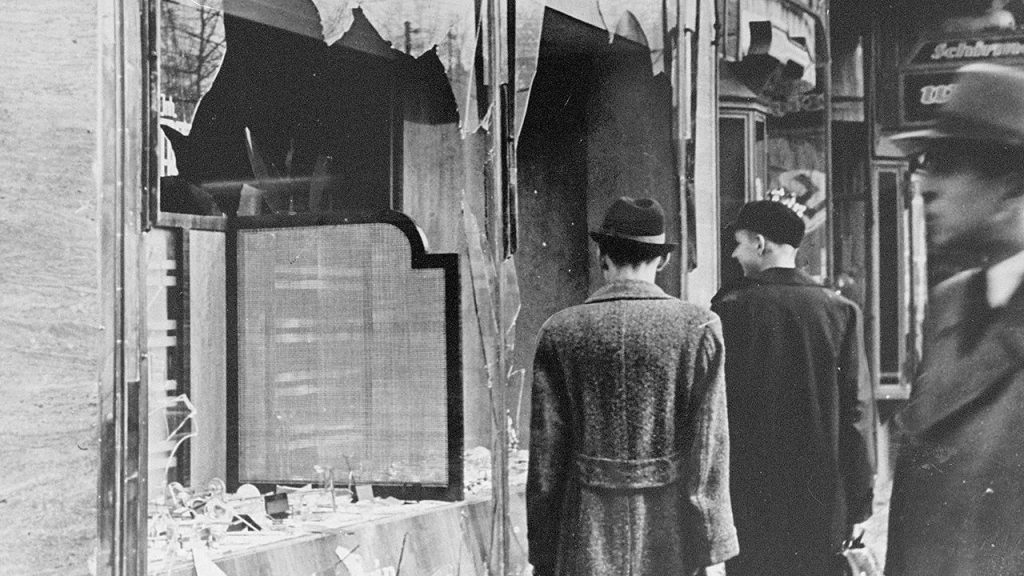In Germany, the Nazis invaded people’s dreams. A remarkable work of journalism, newly translated into English, shows how authoritarianism warps the subconscious.

Above: a vandalized storefront of a shop in Berlin owned by Jews, 10 November 1938. Kristallnacht, or “the Night of Broken Glass”, was the Nazi dictatorship’s declaration of war against German and Austrian Jews and, implicitly, against Jews living anywhere in the world. Across Germany and German-annexed Austria on 9-10 November 1938, the Nazis staged spectacles of vengeance and degradation that shattered far more than glass. For Jewish communities, the extreme hatred unloosed on them made clear, for anyone with eyes to see, that this was a regime capable of anything.
5 June 2025 — In 1933, after Adolf Hitler had taken power, a German housewife dreamed that her stove was snooping on her. “It said everything we’d said against the regime, every joke we’d told” to an eavesdropping stormtrooper. “God, I thought, what is it going to say next? All my little comments about Goebbels?” The woman’s fears about privacy and Hitler’s chief propagandist were recorded by Charlotte Beradt, a Jewish journalist who collected the dreams of Germans under fascism.
Three decades earlier Sigmund Freud had posited that dreams reveal unconscious thoughts. To Beradt, they disclosed truths about authoritarianism that no one would dare say aloud. Some of her subjects were nervous to share their stories. Half a dozen dreamed that it was forbidden to dream. A businessman imagined that Goebbels visited his factory. “It took me half an hour to get my arm raised, millimetre by millimetre,” he recounted. As he struggled to salute, his spine snapped.
Beradt collected dreams from more than 300 people over several years, transcribing them in code. “Party” became “family”; Hitler became “Uncle Hans”. She concealed the records in bookbindings and smuggled them abroad. They were published in Germany in 1966; an early English translation went out of print. Newly translated, the remarkable collection – which is unique in the canon of Holocaust literature – may now find more readers. It arrives at a time when people are more interested in the connection between sleep and well-being than ever before. I was given an old paperback copy, a 1985 reprint of the original, which a colleague found in a Paris bookshop. Those editions now fetch $300 (€265) on Amazon and other book distributors.
Beradt organizes the material into types of dreams, interweaving the accounts with her own trenchant analysis. A man imagines sitting down to write a formal complaint against the regime, but the page he sends in is blank – a dream reflecting his inaction. An eye doctor pictures that he is summoned to treat Hitler because “I was the only one in the world who could; I was proud of myself for that, and felt so ashamed of my pride that I started crying”—a dream suffused with guilt. A young woman envisions having to produce identity papers and she is desperate to prove that she is not Jewish – a dream of racial paranoia.
Many of the dreams are eerily prophetic. The doctor dreams about Nazi militiamen knocking out hospital windows four years before Kristallnacht, the “night of broken glass” (pictured above), when stormtroopers destroyed buildings including synagogues and Jewish-owned businesses. The woman dreams of hiding under “a big pile of dead bodies”. It was the early 1930s, years before the world would learn of the mass murder committed in concentration camps.
The dreams of Germans in the resistance are different. The night before her execution, Sophie Scholl, a 21-year-old activist, dreamed that she was carrying a baby up a mountain to be baptised. Before she could get to the church, a crevasse cracked open on her path; she was able to set the baby down before she disappeared into the chasm. Scholl saw this as a metaphor for the fight against fascism. “The child is our idea, and it will prevail despite all obstacles,” she explained. “We can prepare the way for it, even though we will have to die for it before its victory”.
Beradt puts Jewish dreamers in their own section as their dreams, “sharpened by the acute threat they were under … seem downright clairvoyant”. In 1935 a housewife dreamed that “We shouldn’t go back to our homes, something was going to happen.” She wanders from building to building, seeking refuge and finding none. As Beradt notes, the dream anticipated events to come – the displacement of Jews in hiding during the “final solution”.
Robert Ley, a high-ranking Nazi, suggested in 1938 that the only Germans with any privacy were those sleeping. He underrated the regime’s power. Dreams reflect and refract an individual’s experience, shaped as it is by policy and the public mood.
Even in sleep, the Reich occupied the minds of its subjects.